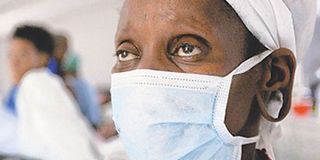Hepatitis kills more people than malaria, Aids or TB, WHO says

A TB patient wears a mask. Virus-caused hepatitis has become a leading cause of death and disability in the world, killing more people in a year than Aids, tuberculosis or malaria, a report said Thursday. FILE PHOTO | NATION MEDIA GROUP
What you need to know:
- There is an effective vaccine and treatment for hepatitis B.
- Kenyan infants are vaccinated against hepatitis B as part of their vaccination schedules.
- A vaccine to prevent hepatitis E virus infection has been developed and is licensed in China, but is not yet available elsewhere.
- There is no vaccine for hepatitis C.
- The introduction of oral medicines, called direct-acting antivirals, has made it possible to potentially cure more than 90 per cent of patients within two three months.
- But there is no effective antiviral treatment for hepatitis D.
Hepatitis — a liver-damaging disease — killed more people in 2013 than the annual deaths caused by malaria, tuberculosis, road injuries or HIV/Aids.
Globally, about 1.5 million people died from hepatitis, which is equal or more than the combined deaths from the other causes, according to the most recent data by the World Health Organisation (WHO).
Coincidentally, only one in 20 people with viral hepatitis know they have it. And just one in 100 people with the disease are being treated, though vaccines and effective treatments are available.
WHO Director-General Margaret Chan said the world “has ignored hepatitis at its peril”.
This is because while deaths from other infectious diseases — diarrhoea, malaria and tuberculosis — are declining, hepatitis is now one of the leading causes of death around the globe.
In fact, in 2013 viral hepatitis was the seventh leading cause of death worldwide, compared with 1990, when it was the 10th.
Dr Chan said: “It is time to mobilise a global response to hepatitis on the scale similar to that generated to fight other communicable diseases like HIV/Aids and tuberculosis.”
Five distinct viruses cause the disease: A, B, C, D and E.
Types A and E are spread through food and water contaminated with faecal matter of an infected person and while it may cause acute illness, the patients usually recover.
MIGHT BE FATAL
However, for pregnant women infected with hepatitis E, it might be fatal.
Types B and C are transmitted through blood and other bodily fluids, and are more lethal and fatal.
They are spread through unsafe sex, during childbirth from an infected mother to her child, contaminated medical equipment and dirty drug needles.
People who are chronically infected with type B can develop liver cirrhosis or even liver cancer.
Hepatitis D is transmitted through contact with infected blood. It only occurs in people who are already infected with the hepatitis B virus.
The data comes a month after the Ministry of Health released a "Report on Occupational Exposure to Blood/Body Fluids and HIV Post Exposure Prophylaxis in Health Care Facilities in Kenya (2011 – 2014)".
The report indicated that despite the risks of contracting Hepatitis B due to exposure to the fluids, many health workers do not access medication to prevent the infections in good time nor do they adhere to guidelines on using them.
The symptoms of the disease include fatigue, nausea, vomiting and jaundice (yellowing of the skin and whites of the eyes), fever, decreased appetite, dark urine, grey-coloured faeces and joint pain.
When it becomes chronic, it can lead to liver failure and death.
According to Graham Cooke, a clinical senior lecturer in infectious diseases at Imperial College London, the disease can sometimes progress for years without symptoms.
The WHO has launched an ambitious target to treat eight million people for hepatitis B or C by 2020. The aim is to reduce new viral hepatitis infections by 90 per cent and to reduce the number of deaths due to viral hepatitis by 65 per cent by 2030.





